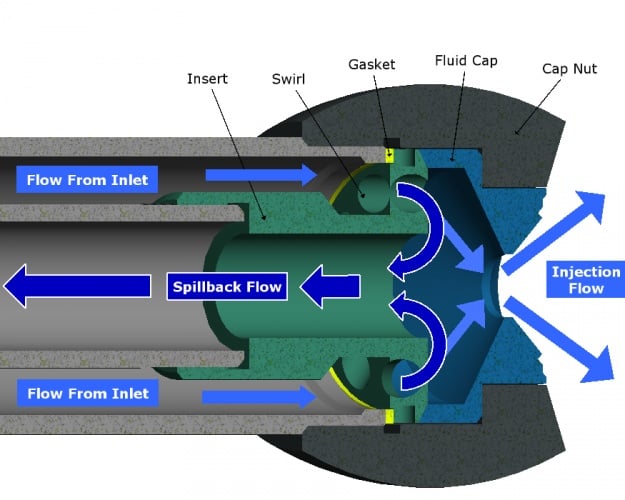
The need to cool a range of media such as gasses is important in many process applications and is often achieved by injecting an atomised spray of cool fluid into a gas flow. The atomised spray is usually propelled through spray nozzles and consists of many small droplets over a large surface area. This ensures that the droplets will quickly exchange heat and evaporate in the gas stream meaning the latent heat of the phase change to gas will be removed from the hot gas. The result is rapid and efficient cooling.
The key to efficient cooling is often maintaining the droplet size of the spray. A small droplet size will result in a bigger surface area per volume of fluid and thus a great interaction with the gas. However, smaller droplets tend to get swept along in a gas flow more rapidly, and so may have a reduced residence time, meaning less time to exchange heat. Gas cooling systems will need to be designed around maintaining specific spray properties to maximise efficiency. This means that any variation in droplet size may negatively impact the effectiveness of the cooling system.
Variable cooling problems
Getting the right cooling spray is relatively simple when the cooling load is constant. Simply calculate the required heat energy that needs to be removed from the system and then match this with the energy required to bring the cooling fluid to equilibrium, normally via a phase change. Then the droplet size required to achieve thermal equilibrium in a reasonable time can be calculated and the correct nozzle(s) can be selected. However, if the load on the cooling system is likely to vary – things become more complex.
In many gas cooling applications the amount of gas needing to be cooled and the temperature of the gas may vary. At first glance it may seem a simple enough problem to solve, simply increase the flow from the nozzles by increasing pressure to compensate for any higher gas flows or additional cooling required.
The problem with this simplistic approach is that flow rate is not the only fluid property changed by increasing the pressure drop across the nozzle. Most importantly droplet size is also likely to change and this will drastically affect cooling.
Increasing pressure to deliver additional flow will lower the droplet size of the spray and this may result in a more rapid heat exchange, although as noted above, the residence time of the smaller droplets will also fall.
This problem is compounded by the fact that hotter, larger gas flows will tend to be moving more rapidly. This can actually result in less cooling per volume of fluid despite the smaller droplet size because the droplets are simply moving too fast to evaporate. Not only will this reduce the efficiency of the cooling system it may also overload any mist eliminators.
Conversely, decreasing pressure to reduce the flow will increase the droplet size. This reduces the surface area of the spray and thus diminishes its cooling effect in a given time slot. As the droplets are now bigger they will take longer to evaporate and so may not achieve complete evaporation in the time required. Partial evaporation can dramatically reduce the amount of cooling because latent heat is normally the biggest component of the heat transfer. Additional problems may also occur if the cooling fluid is only partially evaporated.
Multiple nozzles
One option is to use multiple nozzles. If this is feasible a step change of nozzles can be used to increase or decrease cooling whilst keeping the spray properties (droplet size) consistent. However, the issue with this approach is that it can only move in discrete quanta of sprays. With a 4 nozzle system one could have 1, 2, 3, or 4 /min and nothing in between those steps. If the cooling load was known to fall in several discrete categories then this might be acceptable.
However, this is leaving things to chance when the objective is truly efficient cooling.
What is needed?
In an ideal world what’s required is a cooling system that can deliver a spray with a consistent droplet size but whose volume can be varied without affecting that drop size. If this nozzle could then be controlled by a temperature sensor then more or less fluid can be delivered as the temperature varies. This would result in a stable cooling of the gas, even as gas flows and initial temperature varies.
The solution
One effective and proven solution which has been developed by The Spray Nozzle People (BETE Ltd), is the spill back system.
Now it works
The spill back lance works by atomising the fluid via a swirl chamber and then returns a portion of the fluid back up the lance to be re-circulated. In this way, only a portion of the pumped fluid is actually ejected from the nozzle orifice. The proportion of fluid that is ‘spilled back’ can be controlled by varying the pressure differential between the spill back channel and the feed channel. Therefore, if the pressure of the main inlet fluid is equal to the pressure on the spill back channel, no fluid will be spilled back. By lowering the pressure of the spill back channel a proportion of the feed spray will be diverted back away from the nozzle. The important thing with this method is that the pressure differential across the nozzle orifice remains unchanged and so the spray characteristics including droplet size will also not change as the flow rate drops.




Comment: Brute force can not solve autonomy challenge
There are many many factors affecting how a car should be driven. I drive differently if I have passengers on board and also if I have put a loaded...